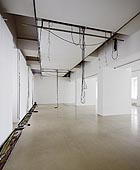
translated and summarized by: Liz Wollner-Grandville,
English summary June 21 - 27
Thyssen-Bornemisza Art Contemporary T-B A21
Tactics of Invisibility
15.04.10 – 15.08.10
On the tracks of the invisible
Of course, it is immediately apparent that this exhibition presents Turkish artistic positions. And of course it would be problematic to declare them as Turkish, as these days the country of origin only plays a minor role. And some of the artists, whose works are shown at the exhibition “Tactics of Invisibility” at the Thyssen-Bornemisza Art Contemporary in Vienna, don’t even live in Turkey.
However, one cannot emphasize enough how important the transfer between Turkish and European art centres is. Unfortunately, the discourse is only slowly picking up in Vienna and therefore Thyssen-Bornemisza’s commitment is all the more significant. “Tactics of Invisibility” is a collaborative project between Arter in Istanbul and Tanas in Berlin.
The exhibition chose an interesting approach: a kind of stocktaking along the borderlines of the ephemeral, hardly tangible. For example, when transitional forms materialize from the trivial to the transcendental, when Islamic prayer rooms take on the character of a DIY store.
On the other hand, Nasan Tur shows Islamic prayer houses in Western cities whose entrances inconspicuously lead into apartment buildings or courtyards. He presents them on surveillance monitors and they appear as undefined “non-locations”. A different generation: Füsun Onur’s installation composed of furniture and objects of everyday-life “Dream of old furniture”.
Noteworthy also the reencounter with Esra Ersen’s school uniform installation, which originated in Linz, as well as Ahmet Ogut’s work. This time Ogut filmed US Army aircrafts, which are no longer in service, at an army base in Arizona. One can easily imagine that the accompanying voice on the audio track, which is heard counting, associates the numbers with war victims or the number of weapons in the arsenals. Works by Inci Eviner, Nilbar Güres, Hafriyat and Ali Kazma are also presented.
Sound, as an invisible component, is also part of the exhibition. Cevdet Erek presents his sound installations and Ayse Erkmen lets white loudspeakers hang from the ceiling, which are systematically combined with lighting fixtures, emitting white light. One approach is called Beethoven, who composed two piano trios –known as “ghost trios” - and which he dedicated to Anna Maria Erdödy. And the Thyssen Bornemisza Art Contempary gallery is located in the palace named after Erdödy.
Erkmen refers to rumours about the existence of a girl’s ghost in the rooms and transformed a canon into a single soprano voice – in a room with white light, in which any artistic presentation disappears as soon as it appears. And before this is the case, one should make sure to visit the exhibition as well as its extension at the Klaus Engelhorn Depot in Vienna’s Ottakring disctrict.
By Roland Schöny
Ausstellung at the KlausEngelhorn Depot
Esra Ersen: I am Turkish, I am Honest, I am Diligent…, 2005
1160 Vienna, Abelegasse 10
Thyssen-Bornemisza Art Contemporary T-B A21
1010 Vienna, Himmelpfortgasse 13/9
www.tba21.org
Hofmobiliendepot – Möbel Museum Wien
Phenomenon IKEA
09.04.10 – 11.07.10
Pimp up IKEA
IKEA is a phenomenon. The Swedish furniture company effortlessly proved that designer pretensions, individual DIY objects and a collective “big family feeling” do not necessarily contradict themselves. The 100 pieces presented at the Hofmobiliendepot demonstrate how IKEA design has developed over the years. Twenty objects are loans from the IKEA museum in Älmhult. The walking-chair design studio constructed pedestals, each 50cm high, out of polyurea and their quasi-organic contours resemble the Swedish Skerry Islands. These islands in turn display classics at eye level such as ÖGLA (1964, Gillis Lundgren), the DIY-version of Thonet chair Nr. 18, creations by Bengt Ruday, one of IKEA’s design pioneers, PS-collections, as well as other objects.
17-year old Ingvar Kamprad founded the company in 1943 and furniture was included in the product line in 1948. The first catalogue was published in 1951; today the catalogue has been published 200 million times in 28 languages. Samples of Austrian catalogues as well as more exotic ones from Israel, China, Japan and Saudi Arabia are displayed at the Hofmobiliendepot. “IKEA is a seismograph of society”, curator Markus Laumann points out. In 1956, the production of DIY furniture began. The modular shelf system IVAR became a synonym for the generation who wanted to set themselves apart from their parents and who preferred to improvise rather than be passive consumers. Until today, 41 million BILLY shelves have been sold worldwide.
In 1977, IKEA opened its first store in Austria and in 1995, the first PS collection was presented at the furniture fair in Milan. Under this label, designers added a pinch of innovation to the serial production: in 1998, Ehlen Johannson reconstructed high voltage isolators as PS Tealight and Nicholai Wilig Hansen placed a red locker horizontally to a sideboard: PS Red Cabinet. Henrik Kjellberg and Mattias Lindqvist transformed a bucket into the droplight PS Lamp. In 2002, Maria Vinka invented the rocking chair PS Gullholmen, made of woven banana fibres on a metal frame, and in 2003, Hanna Ivarsson & Per Ivar Ledang designed the children’s chair PS-Brum, which is also available as cuddly toy.
The pimp up light show on the ground floor, to which six Austrian designers were invited to adapt IKEA objects, is particularly amusing. walking-chair designer Karl Emilio Pirker transformed the white lamp PS MASKROS (Marcus Arvonen) with colourful, translucent plates into a flowerlike lamp called Shiatsu Flower. Vandasye Design (Peter Umgeher and Georg Schnitzer) immersed the full moon white droplight Fado with diverse gray- and black tones into abstract spheres.
By Isabella Marboe
Hofmobiliendepot – Möbel Museum Wien
1070 Vienna, Mariahilfer Strassse 88, Entrance Andreasgass7
www.hofmobiliendepot.at
Kunstraum Niederösterreich
Judith Fegerl – Self
11.06.10 – 24.07.10
Give space
Judith Fegerl’s exhibition at the Kunstraum Niederösterreich reminds of numerous other renowned exhibitions, in which artists placed the exhibition space into the centre of attention or have gone to other extremes: Santioago Serra, Yves Klein, Daniel Buren, Chris Burden and others.
Fegerl’s exhibition, which centres on the exhibition space, is a reference to, and a reflection of, the world of art, artwork, the white cube.
Judith Fegerl applies the stratagem of sci-fi; earlier works by the artist underline this association. The destruction conveyed by wiring torn out of the walls and the darkness of the room correlates with dystopian scenarios: they remind of novels and movies in which space, emptied of all kinds of projections, is left over as a raw setting, sometimes more daunting than expected (Stanislaw Lem’s Futurological Conference, Matrix), as a banal reality (the Enterprise Holodeck, Cronenberg’s eXistenZ) or in which different levels of reality, reality and virtuality, fight each other and overlap at numerous levels of reality (Lem, eXistenZ, Matrix).
On the one hand, the tangle of cables is a reality level behind a concrete architectural space, which is now (allusively) disclosed, and on the other hand – taken out of its “background dwelling” - it also functions as an artwork: composed, put into proportion with the room, arranged in circles and lines, the cables no longer appear as coincidentally hanging down and attain a work character. The wiring marks the places of the sockets, the necessary connection to every black box and any further developed technology to an energy- and electricity network. The contemplation on reality/materiality/virtuality of the artwork occurs through the unclear association of elements to a certain room- and reality level. Self-reflection – which provides the exhibition title. The data lines are also marked by cables, and – set in a loop - are only connected to themselves, and open another, individual dimension of meaning.
By Milena Dimitrova
Kunstraum Niederösterrecih
1010 Vienna, Herrengasse 13
www.kunstraum.net
Albertina
Walton Ford – Bestiarium
18.06.10 - 10.10.10
The Animal time-machine
Viewing Walton Ford’s huge monkey painting “The Sensorium” (2003, 152,4 x 302,3 cm) and at the same time keeping European animal paintings of the 19th century in mind, one is reminded of the Gründerzeit painter Paul Meyerheim (1842-1915), whose “Monkey Banquet” is displayed at the Harvard Museum in Boston. The comparison between Ford’s painting and that of Meyerheim clearly points to the parallels as well as the differences of this genre.
Ford, born 1960 in Larchmont in the state of New York, and who lives in Massachusetts, was fascinated by the works displayed at the Museum of Natural History in New York and by John James Audubon's works (1785 – 1851), the famous ornithologist and animal illustrator. With his large-format paintings rendered in the style of his inspirational sources, Ford developed a unique style. Despite being a modern animal painter he is equally determined to depict his objects in great detail, and like the old masters he narrates civilisation- and cultural critical stories with these remarkably large format aquarelle paintings. It is not a coincidence that Ford’s monumental polar bear scene in “Novaya Zemlya Still Life” (2006) resembles Edwin Landseer’s painting “Man proposes, God disposes” (1863-64), bringing Benjamin Franklin’s catastrophic polar expedition back to memory.
The allegoric moment of Ford’s animal paintings cannot be overlooked. The analogy of the battle for survival of the Tasmanian wolf in “The Island” (2009), a painting composed like a triptych, reminds of the extinction of the Australian mammal. The settlers discredited the predator as a “gory hunter” - after having introduced sheep into the region.
The paintings are set in contrast to historical texts and reports by contemporary witnesses thereby casting an interesting light on the relationship of humans and animals over the course of history. The curators rightfully describe Ford’s work as truly singular in contemporary art. His work is undoubtedly remarkable and his paintings, a mixed technique of aquarelle and gouache colours, ink and pencil on paper, surprises with its loosely set brush strokes. Only at a distance do the feathers and fur attain their vitality. But after a while, the question arises whether the artistic media used is really “contemporary”. Does this 19th century form of animal painting offer anything new about the condition of our planet? Is the use of an old and tried form of art not falling prey to a mannerist style?
Whatever the answers may be, the exhibition offers unusual insights for all those who are interested in animal depictions and/or contemporary US painting.
By Kai Artinger
Albertina
1010 Vienna, Albertinaplatz 1
www.albertina.at
Mehr Texte von translated and summarized by: Liz Wollner-Grandville


 Teilen
Teilen





